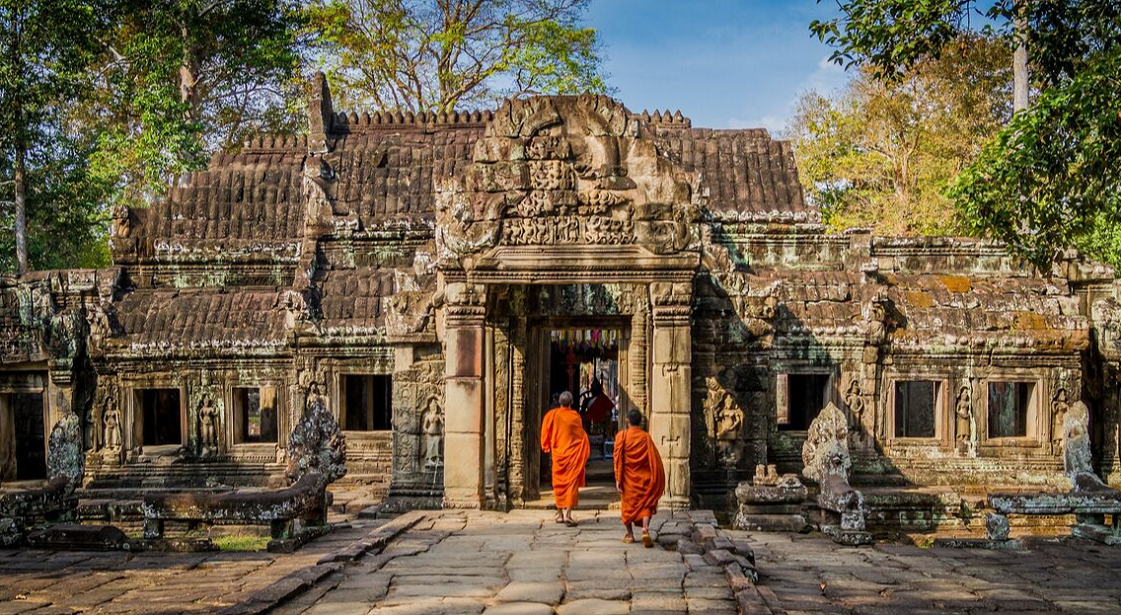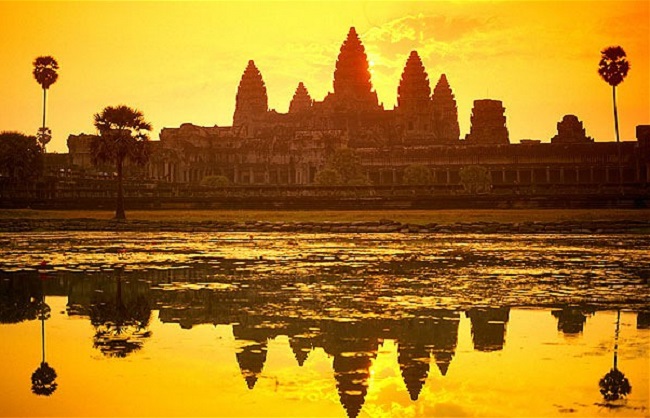Angkor Wat, Cambodia – Temples of Time
Angkor Wat, located in Siem Reap, Cambodia, is not only the world’s largest religious monument but also a timeless symbol of Khmer civilization. Known as the “Temples of Time,” Angkor Wat reflects the grandeur, spirituality, and architectural genius of the Khmer Empire that flourished between the 9th and 15th centuries. Today, it stands as a UNESCO World Heritage Site, drawing millions of travelers, historians, and spiritual seekers each year. Beyond its breathtaking architecture, Angkor Wat represents Cambodia’s cultural pride and resilience, making it one of the most remarkable landmarks on earth.
The Origins of Angkor Wat
Angkor Wat was constructed in the early 12th century during the reign of King Suryavarman II. Originally built as a Hindu temple dedicated to Vishnu, it was later transformed into a Buddhist temple, reflecting Cambodia’s evolving religious identity. The name “Angkor Wat” translates to “City of Temples,” and the structure’s massive scale reflects the ambition of the Khmer kings to showcase their power and devotion to the gods.
Covering over 162 hectares, Angkor Wat is an architectural marvel. Unlike most temples in Angkor that face east, Angkor Wat uniquely faces west, a direction often associated with Vishnu. Its orientation also aligns with celestial events, further highlighting the Khmer Empire’s advanced understanding of astronomy.
Architectural Wonders of Angkor Wat
The temple complex of Angkor Wat is a masterpiece of Khmer architecture, built using sandstone blocks intricately carved with detailed bas-reliefs. Its design symbolizes Mount Meru, the mythical home of the gods in Hindu cosmology. The central tower rises over 65 meters, surrounded by four smaller towers, creating the iconic quincunx arrangement.
Key Architectural Highlights:
-
Moat and Outer Wall – A massive moat measuring 190 meters wide surrounds the temple, symbolizing the oceans around Mount Meru.
-
Causeway and Entrances – Visitors cross a grand sandstone causeway to enter, offering an awe-inspiring first glimpse of the temple.
-
Bas-Reliefs – Stretching nearly 800 meters, the bas-reliefs narrate scenes from Hindu epics such as the Ramayana and Mahabharata, along with depictions of historical Khmer battles.
-
Apsaras (Celestial Dancers) – Over 1,500 carvings of apsaras decorate the walls, each with unique hairstyles, jewelry, and expressions, symbolizing divine beauty.
-
Central Sanctuary – The innermost part of the temple represents heaven itself, a place once accessible only to the king and high priests.
Angkor Wat and the Passage of Time
Known as the “Temples of Time,” Angkor Wat has endured centuries of political upheaval, war, and natural decay. Despite challenges, it remains remarkably preserved compared to other Angkor temples. The temple’s longevity is due to both its ingenious engineering and Cambodia’s dedication to restoration efforts.
For centuries, Angkor Wat was hidden from much of the world until French explorers “rediscovered” it in the 19th century. Its resilience symbolizes the endurance of Cambodian culture through times of hardship, including the Khmer Rouge era. Today, Angkor Wat not only tells stories of ancient civilizations but also stands as a beacon of Cambodia’s cultural revival.
Spiritual Significance
Angkor Wat is more than an architectural masterpiece—it is a sacred space. Initially constructed for Hindu worship, its transformation into a Buddhist site demonstrates Cambodia’s religious harmony. To this day, monks and locals visit the temple for prayer, meditation, and rituals. Sunrise at Angkor Wat is especially revered, as the temple’s silhouette against the glowing sky represents the cycle of life, time, and rebirth.
The alignment of Angkor Wat with solstices and equinoxes further adds to its spiritual depth. During certain celestial events, the sun rises directly over the central tower, creating awe-inspiring moments of connection between earth and sky.
Visiting Angkor Wat Today
For modern travelers, Angkor Wat is a bucket-list destination. Managed by the APSARA Authority, the site welcomes millions of visitors annually. To truly experience its majesty, most tourists arrive at dawn to witness the sunrise, when the temple is bathed in golden light and reflected in the lotus ponds.
Practical Travel Tips:
-
Best Time to Visit – November to March offers cooler, dry weather, making it ideal for exploration.
-
Tickets – Angkor passes are required, available in 1-day, 3-day, or 7-day options.
-
Dress Code – Modest clothing covering shoulders and knees is mandatory, respecting the temple’s sacredness.
-
Guided Tours – Hiring a local guide enriches the visit with historical and cultural insights.
-
Beyond Angkor Wat – Nearby temples such as Bayon (with its smiling stone faces) and Ta Prohm (famous for tree roots enveloping ruins) complete the Angkor experience.
Angkor Wat in Popular Culture
Angkor Wat has also gained fame in global culture. It has been featured in documentaries, literature, and films, such as Lara Croft: Tomb Raider. It appears on Cambodia’s national flag, making it the only country with a monument on its banner, symbolizing its central role in Cambodian identity.
Preserving the Temples of Time
The preservation of Angkor Wat is a global effort. UNESCO and international organizations work alongside Cambodian authorities to ensure the temple withstands threats such as environmental damage, over-tourism, and looting. Sustainable tourism practices are being promoted to balance visitor experience with long-term protection.
Locals also play a vital role, as Angkor Wat provides employment and pride to the Cambodian people. Every ticket purchased supports conservation and community development, ensuring future generations can continue to admire the “Temples of Time.”
 Conclusion: A Journey Through Time
Conclusion: A Journey Through Time
Angkor Wat, Cambodia’s crown jewel, is far more than a collection of ancient ruins—it is a living testament to time itself. The temple embodies the brilliance of Khmer architecture, the devotion of ancient civilizations, and the resilience of modern Cambodia. Whether you visit for history, spirituality, or sheer beauty, Angkor Wat offers an experience like no other.
From sunrise over its towers to quiet reflections among its bas-reliefs, Angkor Wat captures the imagination and soul of every traveler. Indeed, these “Temples of Time” remind us that civilizations may rise and fall, but culture, faith, and human creativity can endure for centuries.


You must be logged in to post a comment.